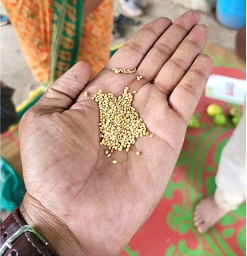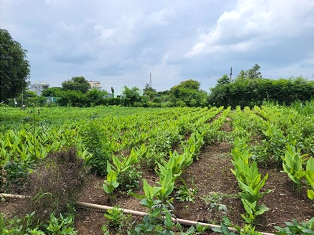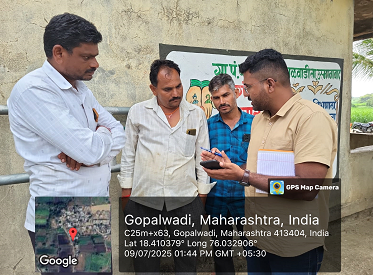Building Resilience through Indigenous Seeds and Sustainable Agriculture: My Field Experience in Dharashiv
Indigenous seeds are naturally strong and can survive droughts, pests, and diseases better
than hybrid seeds. They grow well in local soil and weather conditions and help maintain soil health.
Unfortunately, due to the market push for hybrid seeds, many of these traditional varieties are
disappearing. By building community seed banks, we are helping farmers regain control over their own
seeds, reduce farming expenses, improve biodiversity, and become more resilient to climate challenges.
Along with this, we are also implementing a forward-looking initiative titled
“Creating a
Circular Economic Model – Biomass Mobile Application.” This digital platform aims to
transform
agricultural waste into economic value. Farmers will be able to sell their crop residues
directly
through the app, enabling them to earn additional income instead of burning agriculture
waste in the
fields. By reducing pollution, improving soil health, and promoting cleaner air, this initiative not
only strengthens farmers’ livelihoods but also supports climate-friendly agriculture. It reflects how
modern technology can empower rural communities and drive sustainable development.
During my field visits to villages like Hinglajwadi, Arli BK, Salgara, and Kasbe Tadwale, I interacted
with many farmers and Self-Help Groups (SHGs). Their responses were very encouraging. One inspiring
example is Mahesh Jamale from Kasbe Tadwale, who has developed his own natural fertilizers and manure
using his farm resources. He has also created a small experimental setup on his farm where he tests
traditional seeds and observes their performance. He proudly conserves more than 15 indigenous
guava
varieties and over 20 varieties of lemon, showing how local farmers are actively
contributing to
biodiversity conservation. Meeting farmers like him gives a strong sense that traditional farming
practices still carry immense strength and value.
(Farmer Mahesh Jamale showcasing indigenous millet sourced from Ahmednagar, and indigenous
turmeric cultivation in Kasbe Tadwale village using natural methods without any chemical
fertilizers.)
Some farmers shared that they really want to preserve traditional seeds but lack training
and proper storage facilities. Women in SHGs showed a strong desire to manage these seed banks together,
seeing it as both a farming support system and a livelihood opportunity. Even the Sarpanches and
Grampanchayat members supported the idea and suggested establishing a community shop to make the project
even more sustainable. There are challengestoo. any farmers are still hesitant to move away from hybrid
seeds because they fear lower production. Soil quality has been impacted due to years of chemical
fertilizers usage. Network problems in some villages also create hurdles in using digital platforms
effectively. Farmers need more training in seed preservation and digital solutions. But the positive
attitude and willingness to learn gives us a lot of confidence To build awareness, we conducted discussions with farmers and SHGs, organized small
meetings on natural farming techniques, and supported the identification and storage of native seeds.
Farmers have started documenting seed characteristics and preparing to grow at least one indigenous crop
variety every season, which is a big step toward protecting biodiversity. Working on this project with the United Nations Global Compact Network India (UNGCNI) has
been a truly transformative learning journey for me. Every field visit, conversation, and observation
has helped me realize that farmers are not just food producers — they are knowledge keepers, innovators,
and the backbone of rural economies. They understand their land, weather conditions, soil behavior, and
seed characteristics better than anyone else. Any development work in rural areas must therefore
respect, recognize, and build upon their existing wisdom.
Through these initiatives, I have learned how deeply agriculture is linked with
environmental protection, climate resilience, digital empowerment, and social equity. Farmers are eager
to adopt new ideas when they feel included, respected, and heard. This experience taught me that
development is not only about introducing solutions, but also about listening carefully to the problems,
emotions, and aspirations of the community. I also understood the importance of women’s leadership in
rural development. Women from Self-Help Groups have shown impressive enthusiasm in seed bank management
and digital initiatives. Their participation strengthens decision-making at the household and community
levels, contributing toward gender equality.
(Demonstrating the Biomass Application and guiding farmers on how to use the app effectively
during fieldwork.)
Our work strongly aligns with several Sustainable Development Goals that aim to build a
fair, healthy, and sustainable future. By promoting indigenous seed varieties and climate-resilient
agriculture, the project supports the goal of ensuring Zero Hunger, helping farmers produce food even in
challenging environmental conditions. At the same time, by encouraging the use of natural fertilizers
and reducing agricultural waste, we contribute to Responsible Consumption and Production, which focuses
on protecting resources and reducing harmful practices. These efforts also strengthen Climate Action, as they help minimize pollution, enhance
soil health, and reduce the harmful effects of climate change on farming. Through the conservation of
local biodiversity and traditional crops, our work supports the protection of Life on Land, helping
maintain balanced and healthy ecosystems. Additionally, the active involvement of women farmers and
Self-Help Groups plays a key role in advancing Gender Equality, giving women a stronger voice in
agricultural decision-making and leadership.
To me, this project is not only about conserving seeds or building a digital solution. It
is about restoring confidence in farmers, helping them reduce dependency, and strengthening local
self-reliance. It is about preserving their heritage, their livelihood security, and their right to
sustainable growth. Being part of this initiative has shaped my perspective on development. Real impact
happens when communities take the lead, and we stand behind them as facilitators. I am truly inspired by
the farmers of Dharashiv, and I carry with me a strong belief that the seeds we protect today and the
innovations we introduce will grow into a more resilient and empowered future for farming communities.


My Personal Learning Experience

